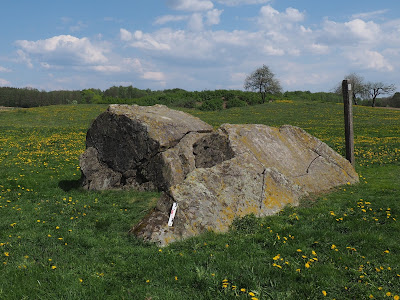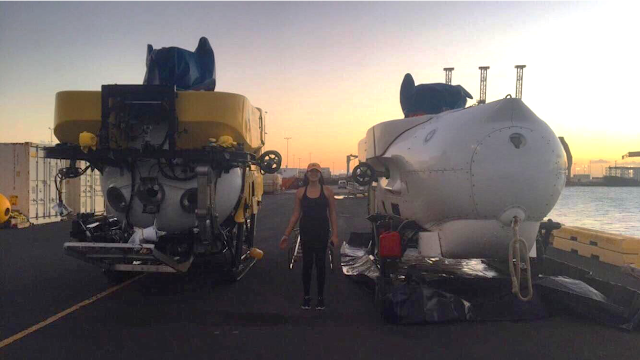Searching for the Right Erratic Boulder
by Karol Tylmann
“I don’t want to look at stones anymore, they don’t say anything” [1]...
...but what if they do have something important to say to us?
 |
| Fig. 1. Erratic boulder in Pomerania, Poland |
Glaciers and ice sheets grew and shrunk many times in response to past climate changes. It is important to know when and how fast it happened, to be able to predict future climate behaviour. But how can we date and reconstruct fluctuations of the Pleistocene ice sheets which disappeared completely ca 10 000 years ago? In fact, stones may be the answer!
Surface exposure dating with cosmogenic nuclides
Today, dating erratic boulders with cosmogenic nuclides is one of the best techniques for tracking the retreat of paleo ice sheets [2]. Cosmogenic nuclides (e.g. 10Be, 36Cl, 26Al, 14C) are formed when high-energy cosmic rays collide with atoms in terrestrial surface rocks and build up predictably with time [3]. Therefore, erratics exposed after deglaciation may be a good target for surface exposure dating with these nuclides and reconstruction of the decay of paleo ice sheets (Fig. 2). It is the only geochronological technique which offers direct dating of the most obvious geomorphological record of paleo ice sheet activity – moraines.
However, not all erratic boulders are “good” enough to be sampled for this kind of dating. The “good” boulders should be intact and stable in the environment since deglaciation, preferably located on the moraine crests. Unfortunately, this is not always the case, especially in regions with a long history of human activity [7].
The “DatErr” project
In 2015 together with my two colleagues, we started the project “Retreat of the last Scandinavian Ice Sheet in Poland inferred from cosmogenic 10Be dating of erratic boulders (DatErr)”. Our goal is to reconstruct the chronology and dynamics of the last ice sheet recession in north Poland based on cosmogenic dating of erratics. The idea of this project was born at the conference in Russia in 2012 during the loooong evening party… as we all know, not only sessions are important during conferences!
The “DatErr” project
In 2015 together with my two colleagues, we started the project “Retreat of the last Scandinavian Ice Sheet in Poland inferred from cosmogenic 10Be dating of erratic boulders (DatErr)”. Our goal is to reconstruct the chronology and dynamics of the last ice sheet recession in north Poland based on cosmogenic dating of erratics. The idea of this project was born at the conference in Russia in 2012 during the loooong evening party… as we all know, not only sessions are important during conferences!
 |
| Fig. 3. Boulder hunters. (A) Hunters on the way. (B) We finally got it! |
We chose cosmogenic beryllium (10Be) for surface exposure dating, because it is produced in one of the most widespread minerals on Earth – quartz. Therefore, we needed quartz-rich erratics, such as granites, gneisses or quartzites. Our first task was to find appropriate boulders. We knew that granitic erratic boulders are one of the most characteristic remnants of the Pleistocene ice sheet in north Poland. However, to find a significant number of “good” boulders, we decided to apply a systematic procedure of searching for and selecting them – we have gradually transformed into boulder hunters (Fig. 3)!
Hunting for boulders
At first, we collected all available information about big erratics located in the study area, which were not dated. We used the following sources of information:
To maximize the chance that our boulders are intact and stable in the environment since the last deglaciation we decided that the “ideal” candidate needs to have the following features:
The next step was selection in GIS based on an analysis of boulder dimensions; boulders smaller than 5 x 0.5 m were filtered out. We found 452 erratics of sufficiently large size. By comparing the terrain relief to the surface sediments from the geology layer we determined the geomorphological context of individual boulders (i.e. the type of landform on which a given erratic is located). We chose landforms related to glacial accumulation (moraines and moraine plateaux, kames, kame terraces, eskers, outwash plains and fans) as a geomorphological context of the right boulders (as they will have been exposed since the last ice sheet retreat). Finally, we found 135 boulders big enough and located on glacial accumulation landforms (Fig. 4).
At first, we collected all available information about big erratics located in the study area, which were not dated. We used the following sources of information:
- lists of natural monuments available in the Regional Directorates for Environmental Protection in Poland
- database of geosites (object with outstanding geological values) available in the Central Registry of the Geosites of Poland
- any useful information about large erratics we could find in catalogues, books, and articles
To maximize the chance that our boulders are intact and stable in the environment since the last deglaciation we decided that the “ideal” candidate needs to have the following features:
- large surface (the wider, the better) and significant height (the taller, the better)
- located on a flat, stable surface
- embedded in the ground (indicating that it was not moved)
- traces of glacial transport and erosion (e.g. striations, crescentic gouges)
- a flat upper surface with no marks of human activity (e.g. carvings, worshipping marks)
The next step was selection in GIS based on an analysis of boulder dimensions; boulders smaller than 5 x 0.5 m were filtered out. We found 452 erratics of sufficiently large size. By comparing the terrain relief to the surface sediments from the geology layer we determined the geomorphological context of individual boulders (i.e. the type of landform on which a given erratic is located). We chose landforms related to glacial accumulation (moraines and moraine plateaux, kames, kame terraces, eskers, outwash plains and fans) as a geomorphological context of the right boulders (as they will have been exposed since the last ice sheet retreat). Finally, we found 135 boulders big enough and located on glacial accumulation landforms (Fig. 4).
The last step was to visit these 135 erratics in the field and to verify their suitability for exposure dating. We visited them during two field seasons of 2015 and 2016. We spent almost two months in the field and travelled over 4 thousand kilometres across north Poland, driving from boulder to boulder. Although it was hard sometimes (especially in forest areas with diverse topography), we found almost all of the selected erratics! We were unable to find 7 boulders because their coordinates or descriptive locations were wrong or possibly because they do not exist anymore – probably there are other boulder hunters (real hunters) treating boulders as a source of rock material. After field inspection of 128 boulders, we excluded 65 erratics as not suitable for surface exposure dating (26 with wrong geomorphological context; 15 excavated, moved, or rotated by humans; 14 too small or too low, 10 with traces of anthropogenic activity). Finally, 63 boulders (granites, granitic gneisses and gneisses) were selected as our targets for sampling (Fig. 4).
So, our hunt was more or less successful. We obtained a population of over 60 intact and stable erratic boulders, which we believe are good candidates for surface exposure dating. You may look forward to new publications about the chronology of the last Scandinavian Ice Sheet retreat in north Poland in journals of glacial geomorphology and geochronology soon…
…because: “These stones are your friends” [1].
Karol Tylmann, PhD
Department of Marine Geology, Institute of Oceanography, University of Gdańsk, Poland
(with support from Piotr P. Woźniak1 and Vincent R. Rinterknecht2)
(1) Department of Geomorphology and Quaternary Geology, Institute of Geography, University of Gdańsk, Poland (2) Laboratoire de Géographie Physique, Université Paris 1, Panthéon-Sorbonne, CNRS, UMR 8591, France
~~~UPDATE - Editor's note: Karol et al.'s paper on erratics selection for cosmogenic nuclide exposure dating has now been published in Baltica. Please go find the paper here to read more about the hunt for the perfect stone.~~~
If you have questions or comments concerning Karol's post, please leave a comment below, or send him an email. You can also connect with him on ResearchGate. ______________________________________________________
References:
[2] Ivy-Ochs S., Briner J.P., 2014. Dating Disappearing Ice. Elements 10: 351-356.
[3] Ivy-Ochs S., Kober F. 2008. Surface exposure dating with cosmogenic nuclides. Eiszeitalter und Gegenwart Quaternary Science Journal 57: 179-209.
[4] https://www.youtube.com/watch?v=48ikKLGUhNs [access: 04.07.2018.]
[5] http://www.cosmogenic-nuclides.de [access: 04.07.2018.]
[6] http://www.antarcticglaciers.org [access: 04.07.2018.]
[7] Akçar, N., Ivy-Ochs, S., Kubik, P.W., Schlüchter, P., 2011. Post-depositional impacts on ‘Findlinge’ (erratic boulders) and their implications for surface-exposure dating. Swiss Journal of Geosciences 104: 445-453.




How would anthropogenic influences change the suitability of these erratics for high resolution and reliable exposure dating?
ReplyDeleteThank you
Hi,
ReplyDeleteFirst, if erratic is excavated or somehow moved by human, we are not sure whether the boulder surface was exposed to the full portion of the incoming cosmic rays since deglaciation. That is why there is a strong dangerous to obtain to young exposure age from this kind of surface. In the literature You may find some examples of cosmogenic exposure ages, which are not logic and mostly too young, when we compare them to the independent chronological data.
Second, if people scratched the boulder surface in the past, tried to destroy erratic, or use boulders as a source of rocks, these kind of boulders are not suitable as well. In all cases when we are not sure, that the surface of the boulder is original, we should avoid sampling. These is because any removal of the surface layer of the boulder, also removes cosmogenic nuclides accumulated the sample and thus produces younger than expected ages.
So, as a result You may obtain even ages of high precision, but the accuracy of dating will be very low, i.e. all ages will be well clustered, but all will be much too young.
Too explore this subject You may read the article [7] from the reference list of the post.
Karol